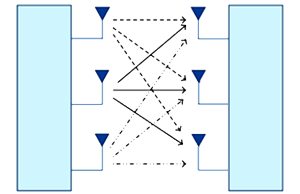MIMO semi-blind channel estimation by using Tikhonov regularized MMSE and MAP algorithms with Householder transformation based QR decomposition
DOI:
https://doi.org/10.3103/S0735272721040014Keywords:
MAP, MIMO communication, channel estimation, Tikhonov regularization, QR decomposition, MMSEAbstract
In this paper, we present novel semi-blind channel estimation schemes for Rayleigh fading Multi-Input Multi-Output (MIMO) channel. Here channel matrix H is decomposed as an upper triangular matrix R, which can be estimated blindly using the Householder transformation based QR decomposition of received output covariance matrix and Q matrix, which can be estimated using the Tikhonov regularization-based MAP (maximum a posteriori) and MMSE (minimum mean square error) techniques with the help of singular value decomposed orthogonal pilot symbols. Simulation results in terms of BER performance obtained for BPSK and 4-PSK data modulation schemes using Alamouti coded 2×6 (2 transmitter and 6 receiver antennas) and 2×8 (2 transmitter and 8 receiver antennas) cases by choosing different values of regularization parameter λ. Appropriate choice of regularization parameter can be calculated using discrepancy principles that gives better performance in terms of BER. The paper proposes the novel semi-blind channel estimation approach using the Householder QR decomposition based blind estimation of R and Tikhonov regularized based MMSE and MAP algorithms using pilot symbols for estimation of Q will yield good results in channel estimation methods.
References
- M. A. M. Moqbel, W. Wangdong, A. Z. Ali, “MIMO channel estimation using the LS and MMSE algorithm,” IOSR J. Electron. Commun. Eng., vol. 12, no. 01, pp. 13–22, 2017, doi: https://doi.org/10.9790/2834-1201021322.
- M. Biguesh, A. B. Gershman, “Training-based MIMO channel estimation: a study of estimator tradeoffs and optimal training signals,” IEEE Trans. Signal Process., vol. 54, no. 3, pp. 884–893, 2006, doi: https://doi.org/10.1109/TSP.2005.863008.
- A. K. Jagannatham, B. D. Rao, “Whitening-rotation-based semi-blind MIMO channel estimation,” IEEE Trans. Signal Process., vol. 54, no. 3, pp. 861–869, 2006, doi: https://doi.org/10.1109/TSP.2005.862908.
- S. Konstantinidis, S. Freear, “Performance analysis of Tikhonov regularized LS channel estimation for MIMO OFDM systems with virtual carriers,” Wirel. Pers. Commun., vol. 64, no. 4, pp. 703–717, 2012, doi: https://doi.org/10.1007/s11277-010-0214-2.
- F. Wan, W.-P. Zhu, M. N. S. Swamy, “Perturbation analysis of subspace-based semi-blind MIMO channel estimation approaches,” in 2008 IEEE International Symposium on Circuits and Systems, 2008, pp. 129–132, doi: https://doi.org/10.1109/ISCAS.2008.4541371.
- P. Meerasri, P. Uthansakul, M. Uthansakul, “Self-interference cancellation-based mutual-coupling model for full-duplex single-channel MIMO systems,” Int. J. Antennas Propag., vol. 2014, pp. 1–10, 2014, doi: https://doi.org/10.1155/2014/405487.
- J. Gao, H. Liu, “Low-complexity MAP channel estimation for mobile MIMO-OFDM systems,” IEEE Trans. Wirel. Commun., vol. 7, no. 3, pp. 774–780, 2008, doi: https://doi.org/10.1109/TWC.2008.051072.
- J. Bhalani, R. Patel, S. Patel, “Performance analysis and implementation of different modulation techniques in Almouti MIMO scheme with Rayleigh channel,” in International Conference on Recent Trends in Computing and Communication Engineering, 2013, pp. 84–87, uri: https://www.seekdl.org/conferences/paper/details/1323.html.
- K. B. Petersen, M. S. Pedersen, The Matrix Cookbook. Lyngby: Technical University of Denmark, 2012, uri: https://www.math.uwaterloo.ca/~hwolkowi/matrixcookbook.pdf.
- J. Proakis, M. Salehi, Digital Communications, 5th ed. New York: McGraw-Hill Science/Engineering/Math, 2007, uri: http://www.amazon.com/Digital-Communications-Edition-John-Proakis/dp/0072957166.
- D. Pal, “Fractionally spaced semi-blind equalization of wireless channels,” in [1992] Conference Record of the Twenty-Sixth Asilomar Conference on Signals, Systems & Computers, 1992, pp. 642–645, doi: https://doi.org/10.1109/ACSSC.1992.269117.
- E. de Carvalho, D. T. M. Slock, “Asymptotic performance of ML methods for semi-blind channel estimation,” in Conference Record of the Thirty-First Asilomar Conference on Signals, Systems and Computers (Cat. No.97CB36136), 1998, vol. 2, pp. 1624–1628, doi: https://doi.org/10.1109/ACSSC.1997.679177.
- A. Medles, D. T. M. Slock, E. De Carvalho, “Linear prediction based semi-blind estimation of MIMO FIR channels,” in 2001 IEEE Third Workshop on Signal Processing Advances in Wireless Communications (SPAWC’01). Workshop Proceedings (Cat. No.01EX471), 2001, vol. 2001-Janua, pp. 58–61, doi: https://doi.org/10.1109/SPAWC.2001.923843.
- A. Jagannatham, B. D. Rao, “A semi-blind technique for MIMO channel matrix estimation,” in 2003 4th IEEE Workshop on Signal Processing Advances in Wireless Communications - SPAWC 2003 (IEEE Cat. No.03EX689), 2004, vol. 2004-Janua, pp. 304–308, doi: https://doi.org/10.1109/SPAWC.2003.1318971.
- X. Liu, F. Wang, M. E. Bialkowski, “Investigation into a whitening-rotation-based semi-blind MIMO channel estimation for correlated channels,” in 2008 2nd International Conference on Signal Processing and Communication Systems, 2008, pp. 1–4, doi: https://doi.org/10.1109/ICSPCS.2008.4813728.
- Q. Zhang, W.-P. Zhu, Q. Meng, “Whitening-rotation-based semi-blind estimation of MIMO FIR channels,” in 2009 International Conference on Wireless Communications & Signal Processing, 2009, pp. 1–4, doi: https://doi.org/10.1109/WCSP.2009.5371541.
- J. Bhalani, D. Chauhan, Y. P. Kosta, A. I. Trivedi, “Novel semi-blind channel estimation schemes for Rician fading MIMO channel,” Radioelectron. Commun. Syst., vol. 55, no. 4, pp. 149–156, 2012, doi: https://doi.org/10.3103/S0735272712040012.
- S. B. Patel, J. Bhalani, Y. N. Trivedi, “Performance of full rate non-orthogonal STBC in spatially correlated MIMO systems,” Radioelectron. Commun. Syst., vol. 63, no. 2, pp. 88–95, 2020, doi: https://doi.org/10.3103/S0735272720020041.
- P. Sagar, B. Jaymin, “Near optimal receive antenna selection scheme for MIMO system under spatially correlated channel,” Int. J. Electr. Comput. Eng., vol. 8, no. 5, p. 3732, 2018, doi: https://doi.org/10.11591/ijece.v8i5.pp3732-3739.
- K. C. Jomon, S. Prasanth, “Joint channel estimation and data detection in MIMO-OFDM using distributed compressive sensing,” Radioelectron. Commun. Syst., vol. 60, no. 2, pp. 80–87, 2017, doi: https://doi.org/10.3103/S0735272717020029.


